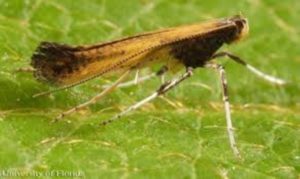The Azalea Leafminer (Caloptilia azaleella) produces plant symptoms that are typically subtle & can often be overlooked. Symptoms from this caterpillar can also confuse people by having both leafminer & leafroller stages. The early instar stages are leafminers, while the later instar stages are leafrollers or leaftiers. Commercial nurseries generally have more concerns with this pest, while they often receive little attention in the landscape. Although the Azalea Leafminer has 2+ generations per year, the azalea (Rhododendron genus) is the only known host of this native caterpillar having the unique one-two punch.
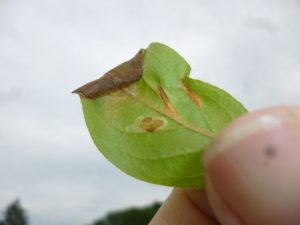
Azalea Leafminers: Symptom stages from 3 leafmines & a single leafroller (Photo Credit: Steven Rettke of RCE)
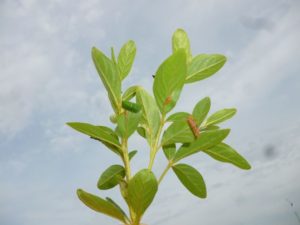
The leafminer symptom damage on this azalea branch are mild or moderate. (Photo Credit: Steven Rettke of RCE)
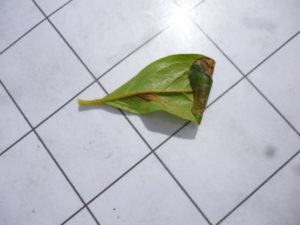
The leafroller symptom stage on this azalea leaf is more obvious than the leafminer symptom. (Photo Credit: Steven Rettke of RCE)
Although the leafminer stages occur first on infested azaleas, the more casual observer will typically not see the plant symptoms until the later leafroller stages. The curled upper leaf tips or side margins create symptoms that are more apparent, but by this late stage the caterpillar larvae may have already pupated & emerged as adults. The best time to detect & apply controls against this pest is during the early leafminer stages in the months of May or July. In NJ, when the larvae reach the larger stage of development in early June or again in early August, then they leave the mines & move out to form the leafroller stages.

The larger leafroller larva is exposed by unfolding the curled leaf tip. (Photo Credit: Steven Rettke of RCE)
By late June, in our southern NJ nurseries, the 1st generation adults have already emerged. If leaf symptoms have been significant, especially if many leaves have turned brown & dropped prematurely, then controls against the upcoming 2nd generation will need to be made in July. Adults are now actively inserting eggs under leaf tissue near the mid-ribs. Typically, one to five eggs are inserted per leaf & thus each leaf can have several blotch or elongated mines. However, usually only a single late stage caterpillar (1/2 inch) per leaf will feed inside the curled leaf tips they create with silk where they then continue to feed until they pupate. Any other later caterpillars emerging from mines on the same leaf appear to usually migrate to other adjacent non-infested leaves where they curl the leaf tips to complete their life cycle development.
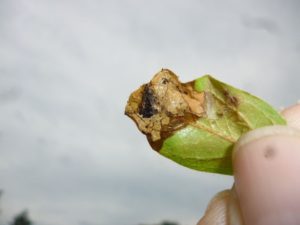
Empty leafroller stage on opened leaf. In south Jersey during late June the caterpillars pupate & emerge as adults. (Photo Credit: Steven Rettke of RCE)
Populations of adult egg laying moths can be estimated during the weeks of late June & early July by shaking the plants & forcing them to fly around briefly. The adult moths are yellowish brown & are about 3/8 of an inch in size. When at rest their wings are folded & adults stand at a 60° angle. In southern NJ counties, adults that emerge from the 2nd generation in August will then lay eggs & actually start a partial 3rd generation. The larvae or pupae of this generation will overwinter within the leaves.
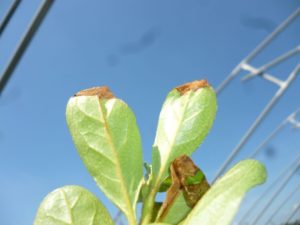
Both azalea leaves have leafroller caterpillar symptoms, but do not have any leafmines. (Photo Credit: Steven Rettke of RCE)
During the coming weeks of July, if numerous blotch mines are observed within the Azalea leaves, then controls will be warranted. Foliar absorbed insecticides will generally give best efficacy. Examples of some of these materials include abamectin, acephate, acetamiprid, azadirachtin, chlorantraniliprole & spinosad. Although, the various systemic neonicotinoid insecticides can provide suppression, they do not give best efficacy results against caterpillars. Properly timed contact type insecticide sprays targeting egg-laying adults during late June/early July or in August can also be effective.
